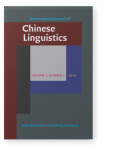Vol. 3:1 (2016) ► pp.132–159
Decomposing polysemy
A structural perspective from the ka-construction in Taiwan Southern Min
The ka-construction in Taiwan Southern Min is well-known for its polysemy. This study argues that with evidence from extra-argumentality, ka-NP position, thematic relationship, passivization, over-generalization, and dialectal difference, ka should at least be categorized into three different types, i.e., light verb, applicative, and preposition, instead of a uniform one. The first type involves the disposal patient/theme and the goal/source constructions where ka is a light verb taking a reduced VP complement. The second one applies to the benefactive/adversative construction where ka is a high applicative head mediating the relation between the ka-NP and a VoiceP. The third one accounts for the non-gapped dative construction where ka is a preposition heading a PP that modifies a VP. By so doing, the polysemy is simply an interplay between different types of ka and their corresponding syntactic structures.
